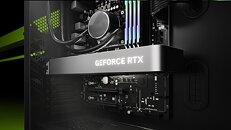- Joined
- Aug 19, 2017
- Messages
- 2,999 (1.07/day)
Recent leaks have unveiled specifications for NVIDIA's upcoming RTX 5070 Ti graphics card, suggesting an increase in power consumption. According to industry leaker Kopite7kimi, the RTX 5070 Ti will feature 8,960 CUDA cores and operate at a 300 W TDP. In a departure from previous generations, the RTX 5070 Ti will reportedly share the same GB203 die with its higher-tier sibling, the RTX 5080. This architectural decision differs from the RTX 40-series lineup, where the 4070 Ti and 4080 utilized different dies (AD104 and AD103, respectively). This shared die approach could potentially keep NVIDIA's manufacturing costs lower. Performance-wise, the RTX 5070 Ti shows promising improvements over its predecessor. The leaked specifications indicate a 16% increase in CUDA cores compared to the RTX 4070 Ti, though this advantage shrinks to 6% when measured against the RTX 4070 Ti Super.
Power consumption sees a modest 5% increase to 300 W, suggesting improved efficiency despite the enhanced capabilities. Memory configurations remain unconfirmed, but speculations about the card indicate that it could feature 16 GB of memory on a 256-bit interface, distinguishing it from the RTX 5080's rumored 24 GB configuration. The positioning across the 50-series GPU stack of this RTX 5070 Ti appears carefully calculated, with its 8,960 CUDA cores sitting approximately 20% below the RTX 5080's 10,752 cores. This larger performance gap between tiers contrasts with the previous generation's approach, potentially indicating a more defined product hierarchy in the Blackwell lineup. NVIDIA is expected to unveil its Blackwell gaming graphics cards at CES 2025, with the RTX 5090, 5080, and 5070 series leading the announcement.

View at TechPowerUp Main Site | Source
Power consumption sees a modest 5% increase to 300 W, suggesting improved efficiency despite the enhanced capabilities. Memory configurations remain unconfirmed, but speculations about the card indicate that it could feature 16 GB of memory on a 256-bit interface, distinguishing it from the RTX 5080's rumored 24 GB configuration. The positioning across the 50-series GPU stack of this RTX 5070 Ti appears carefully calculated, with its 8,960 CUDA cores sitting approximately 20% below the RTX 5080's 10,752 cores. This larger performance gap between tiers contrasts with the previous generation's approach, potentially indicating a more defined product hierarchy in the Blackwell lineup. NVIDIA is expected to unveil its Blackwell gaming graphics cards at CES 2025, with the RTX 5090, 5080, and 5070 series leading the announcement.

View at TechPowerUp Main Site | Source











